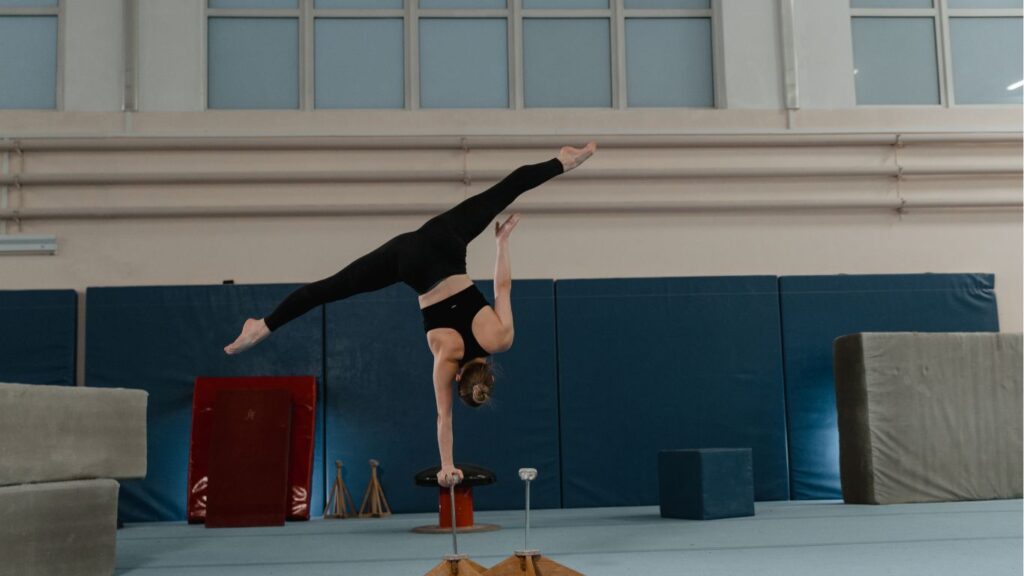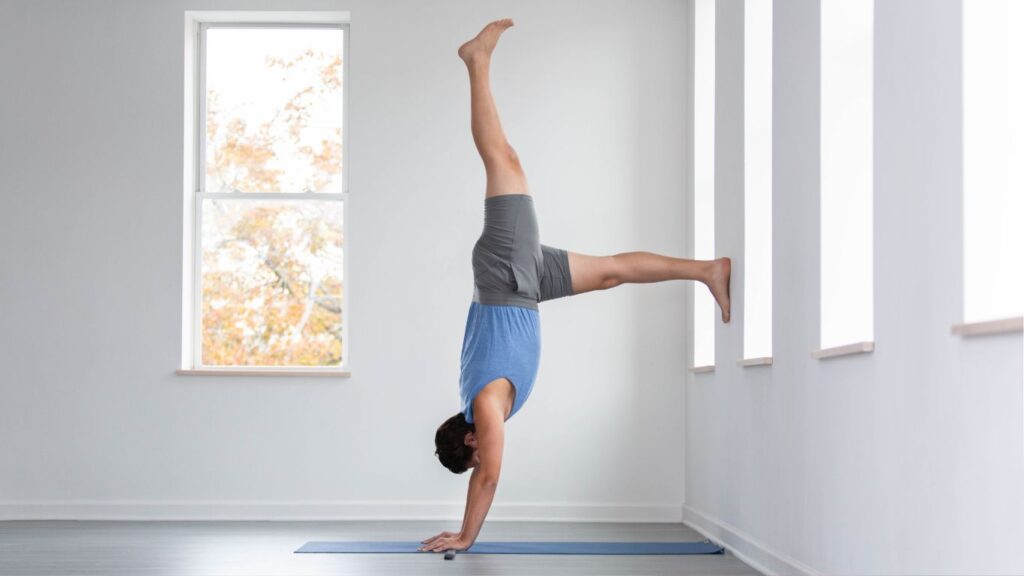Handstands, a cornerstone of gymnastics and acrobatics, have a rich history in physical fitness, tracing back to ancient practices in Chinese and Indian cultures. Traditionally celebrated for their display of strength and balance, handstands have evolved from circus showcases to a mainstream fitness trend. This surge in popularity is partly due to the holistic approach to health they embody, seamlessly integrating into various workout routines. By incorporating handstands into your regimen, you stand to gain not just muscular strength and improved balance but also enhanced flexibility and a fortified mental resilience. This multifaceted exercise doesn’t just sculpt the body; it challenges the mind, making it a comprehensive tool for personal fitness evolution. Hence, adopting handstands into daily exercise routines can be a transformative step, promising a well-rounded enhancement of one’s physical and mental fitness.
Integrating Handstands into Your Workout Routine: A Game-Changer for Your Fitness Journey
The Foundations of Handstand Fitness
Core Strength
Handstands are an exceptional exercise for engaging and fortifying the core muscles. By maintaining an inverted position, the body relies on the deep abdominal muscles, obliques, and lower back to stabilize itself, leading to a stronger and more defined core. This increased core stability is pivotal not only in enhancing one’s performance in a variety of other exercises but also in improving posture, reducing the risk of injuries, and facilitating everyday activities such as bending, lifting, and twisting. A strong core is the foundation of a healthy, active body, making handstands a valuable addition to any fitness routine.
Upper Body Development
Handstands exert a profound impact on upper body strength, particularly targeting the shoulders, arms, and wrists. By supporting the body’s entire weight with the arms and shoulders, it demands and develop muscular endurance and strength in these areas, as well as in the wrists, which must stabilize the body. The compound nature of this exercise means it simultaneously works multiple muscle groups, offering a comprehensive upper body workout. This multifaceted approach not only builds muscular strength but also enhances coordination and balance, making handstands a potent exercise for anyone looking to intensify their upper body fitness regime.
Balance and Coordination
Practicing handstands significantly enhances balance and coordination by challenging the body to maintain stability in an inverted position. This process crucially involves proprioception, the body’s ability to sense its position and movement in space. As you engage in handstands, your body becomes more attuned to its spatial orientation, improving your proprioceptive abilities. This heightened awareness allows for better control over movements, both in daily activities and other physical pursuits. Over time, the act of balancing in a handstand strengthens the neural connections related to body positioning, leading to improved coordination and a refined sense of balance.

Health and Wellness Benefits
Improved Circulation
Inverted poses, like handstands, have a unique impact on blood flow and cardiovascular health, reversing the effects of gravity on the body. This inversion aids in venous return, enhancing circulation and potentially improving heart function over time. The increased blood flow to the brain that occurs during these poses can lead to notable benefits for mental health and cognitive function. Enhanced concentration, mental clarity, and even mood improvement are often reported, as the brain receives a boosted supply of oxygen and nutrients. This can lead to better cognitive performance, reduced stress levels, and a general sense of mental well-being.
Flexibility and Posture
Handstands play a significant role in improving overall body flexibility, particularly in the shoulders, back, and hips. The inversion required in a handstand stretches and strengthens these areas, promoting a greater range of motion. Additionally, the alignment needed to achieve and maintain a handstand encourages the correction of common postural issues. By engaging the core and aligning the spine during a handstand, individuals can develop a better posture over time, as the exercise naturally counteracts the forward-leaning posture many adopt from sitting or computer work. This can lead to reduced back pain and a more balanced, upright posture.
Mental and Emotional Gains
Overcoming Fear
Mastering a handstand offers profound psychological benefits, chief among them the overcoming of fear and the development of perseverance. The initial fear of falling is a significant hurdle for many, but conquering it through gradual practice embodies a powerful lesson in courage and resilience. This journey fosters a mindset of perseverance, as achieving a handstand often requires consistent effort and patience. Furthermore, the challenge of mastering such a complex skill promotes personal growth, instilling confidence and a sense of achievement. It teaches the value of setting goals and the satisfaction derived from pushing one’s limits, contributing to a more resilient and determined character.

Confidence and Self-Esteem
Achieving milestones in handstand practice is a significant confidence and self-esteem booster. Each progress step, from holding a handstand for a few seconds to achieving full stability, serves as a tangible proof of personal growth and physical capability. This journey of mastering one’s body weight empowers individuals, showcasing the remarkable feats the body can achieve through dedication and practice. The empowerment derived from handstand mastery goes beyond physical strength; it fosters a profound sense of self-belief and accomplishment. This newfound confidence can permeate other areas of life, encouraging a more assertive and positive approach to challenges and goals.
Integrating Handstands into Your Workout Routine
- Basic Steps for Beginners:
- Start with wrist warm-ups to prepare your joints for the weight-bearing activity.
- Practice plank positions and hollow body holds to build core strength and stability.
- Begin with wall handstands to get accustomed to the inverted position with support.
- Precautions for Beginners:
- Ensure ample space around you to avoid injuries in case of falls.
- Use a soft surface or yoga mat for wrist comfort and safety.
- Listen to your body and avoid overstraining to prevent injuries.
- Recommended Exercises:
- Wrist Strengthening Exercises: wrist curls and extensions.
- Core Exercises: planks, hollow holds, and leg raises.
- Shoulder and Upper Body Strength: push-ups, dips, and pike push-ups.
Progression and Variation
Tips for Advancing Your Practice:
- Gradually increase the time spent in the handstand position.
- Practice away from the wall to develop balance and confidence.
- Focus on form and alignment to build a solid foundation.
Incorporating Variations:
- Straddle Handstand: Helps with balance and distributes weight differently.
- Walking Handstand: Enhances shoulder strength and control.
- Handstand Push-Ups: Increases upper body strength and endurance.
Keeping the Workout Engaging:
- Set specific goals, like achieving a freestanding handstand or holding it for a longer duration.
- Challenge yourself with new variations to continually test your balance and strength.
- Record your progress to visually see your improvement over time, adding motivation and a sense of accomplishment.

Conclusion
Incorporating handstands into your workout routine offers a unique blend of physical and psychological benefits that can transform your fitness journey. From building core strength and improving balance to enhancing mental clarity and boosting self-confidence, the advantages of mastering handstands are comprehensive. As you progress and experiment with variations, handstands keep your workouts fresh, challenging, and rewarding. Whether you’re a beginner taking the first steps or an experienced practitioner exploring advanced variations, the journey of integrating handstands into your routine promises not only to elevate your physical capabilities but also to inspire personal growth and resilience. Embrace the challenge, and let handstands revolutionize your approach to fitness.
Also read: Shake it Off: The Benefits of Dance-Inspired Fitness Workouts
